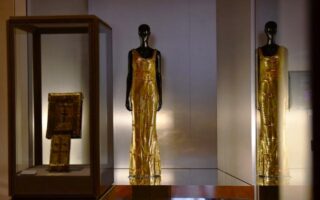A Modern Cartoonist’s Surrealist Visit to L’Espace Dali in Montmartre
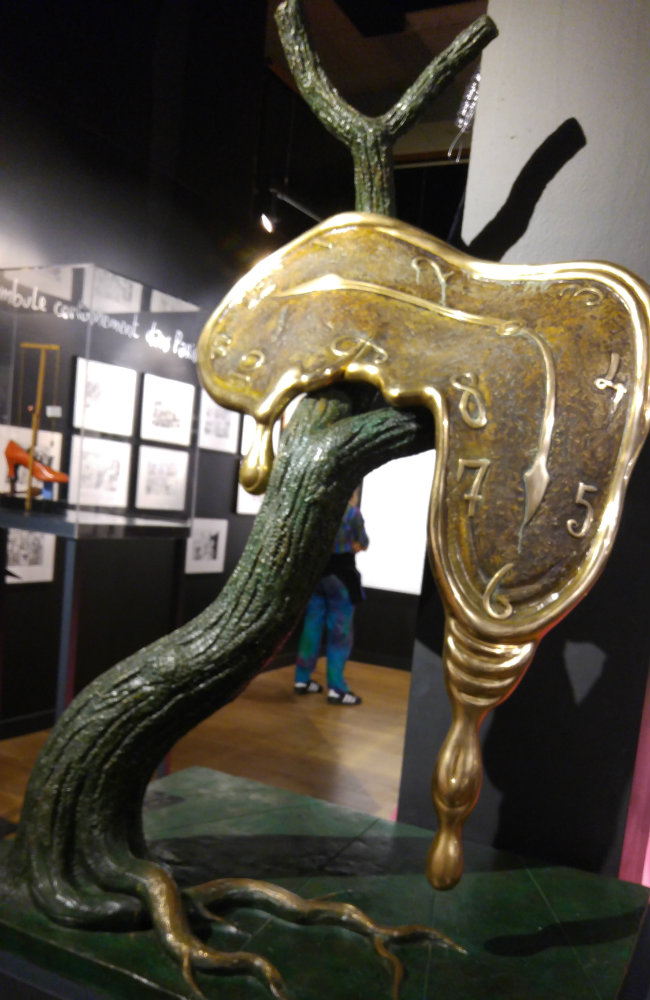
- SUBSCRIBE
- ALREADY SUBSCRIBED?
BECOME A BONJOUR PARIS MEMBER
Gain full access to our collection of over 5,000 articles and bring the City of Light into your life. Just 60 USD per year.
Find out why you should become a member here.
Sign in
Fill in your credentials below.
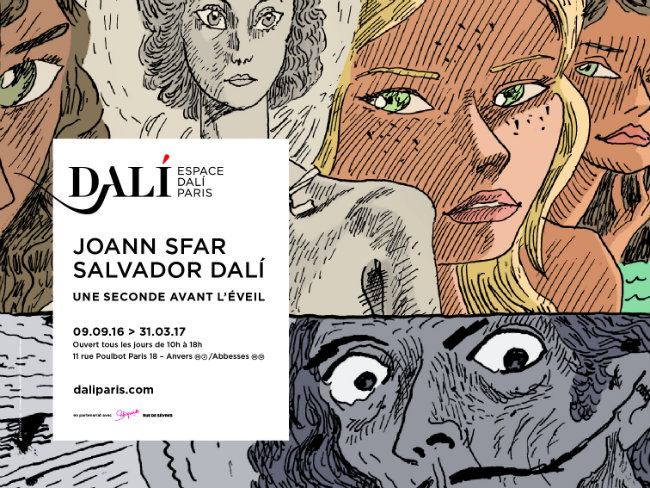
“Joann Sfar – Salvador Dali, une seconde avant l’éveil” exhibition at the Espace Dali
A bizarre and exciting temporary exhibit was installed a few weeks ago within the existing permanent exhibit of Salvador Dalí’s works at the Espace Dalí in Montmartre. It is an entrancing and complex exhibit. I visited it thrice during my recent Paris sojourn, and will go back yet another time if I find myself in Paris before it leaves on March 31 of next year.
I have always found the Dalí museum — called Espace Dalí — a little gem of a museum, an intimate space with almost a church-like feeling in a quiet corner of the Butte Montmarte just around the corner from the craziness of Place du Tertre. It’s the perfect venue to take in the strange and wonderful works of Dalí slowly and quietly as is appropriate. I have visited numerous times and each time, I see details I had not noticed before.
[Related article: Following in Salvador Dalí’s Footsteps in Paris]
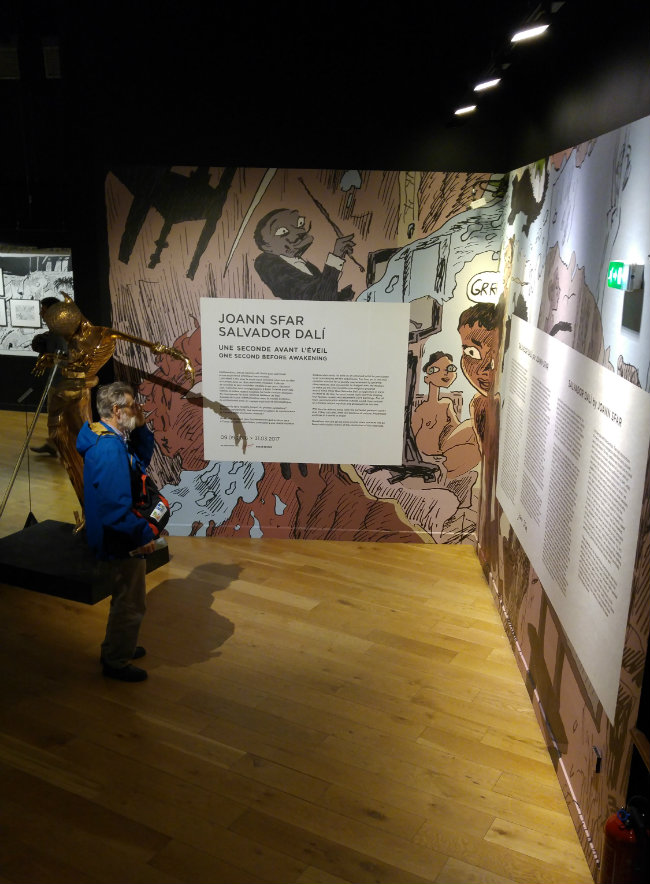
Entering the exhibition. Photo: Michele Kurlander
Surrealism is a form of art depicting the artist’s visions while in a sort of delirium – in a kind of dream state free of rational control. Viewing good surrealist works is to me just plain fun – and I have a special love for Dalí’s works – whether or not I always understand his symbolism.
Some of his symbols have come to be known well: the drawers (memory and unconscious – concealed sexuality), ants (decay and decomposition), melting clocks (omnipresence and the flow of time), and crutches (reality; an anchor). Sometimes the symbolism is not so clear, but this allows my imagination also to run free.
Espace Dalí houses the largest collection of Salvador Dalí artworks in France – including paintings, prints and sculptures – running the gamut from the dreamlike, erotic and theatrical to the drole and poetic, and including such well known sculptural pieces as the melting clock, Alice in Wonderland, the skinny legged elephant adorned with an obelisk and the snail with wings; and such hanging artworks as the “Dali Illustre Casanova” suite, which includes the “Nude and Lobster” piece juxtaposing a lobster with a nude female crotch.
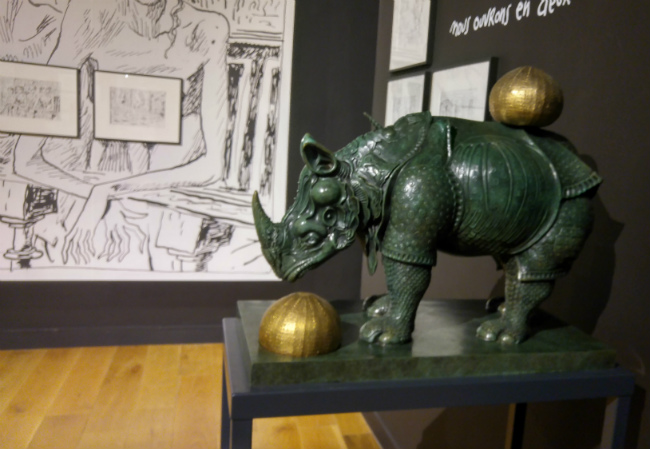
“Joann Sfar – Salvador Dali, une seconde avant l’éveil” exhibition at the Espace Dali. Photo: Michele Kurlander
This new Joann Sfar exhibit of surrealist cartoons by the renowned cartoonist literally wraps around the space of the Dalí museum – recreating through his cartoon drawings what Sfar describes as a tour of Dalí’s brain through dreams and reality– a tour experienced by him and four fashion models who during their time together sometimes wore dresses designed by Italian designer Elsa Schiaparelli (with whom Dalí at one time collaborated) but, for the most part, wore nothing at all (duplicating a famous photo of Dalí with four nudes). As described by Monsieur Sfar, they thus interacted with each other and with reproductions of Dalí’s works and through those interactions could call forth the great man’s spirit.
Sfar is a well known French comic book creator and artist, novelist and film director, known for, among other things, being one of the most important artists in the new wave of Franco Belgian comics, a co-creator of the Donjon series, and the creator of children’s books such as “The Rabbi’s Cat” (“Le chat du rabbin”) and the graphic novel version of Le Petit Prince. He is also the writer/director of “Gainsbourg: Vie Heroique” -a biopic that used fantasy artwork, puppetry and animation.
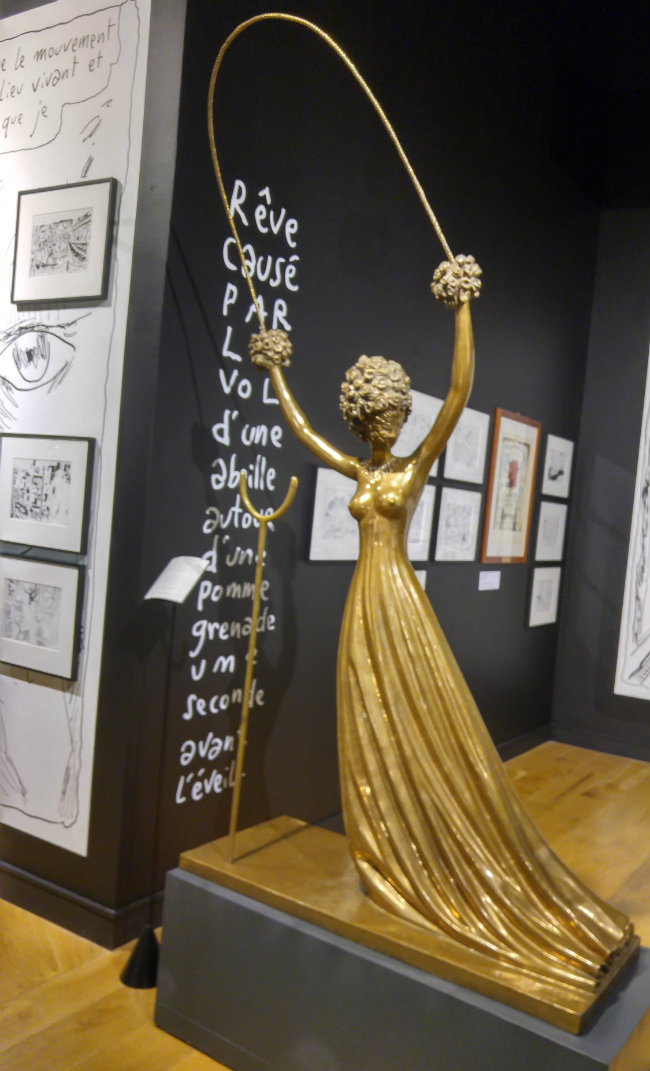
The exhibition at the Espace Dali. Photo: Michele Kurlander
When visiting Espace Dalí you enter the museum from street level as if visiting a small residence and then, after paying the entrance fee, climb down a flight of stairs to the lower level where, as you enter the gallery, the first wall – seemingly pointed out by the clawlike extended hand of Dalí’s strange sculpture of a Woman with a Head of Roses – features one of Sfar’s brilliantly colored cartoon drawings framing an explanation of the exhibit.
Sfar explains there that the models were encouraged to recreate the works through gestures, dance and theater so that Dalí himself could be “recreated” through his artworks – a sort of cryogenic process that Sfar insists is required to save the world. He apparently feels that art rather than religion is required to save a world that is sinking into “obscurantism.” He goes on to say that the idea that a “priest knows more than a painter” is “absurd” – and that in the end “nothing is more alive than the emotion that you feel when you finally understand a painting” and that, finally, he was through the experience of preparing to mount this exhibit “forever changed” by the consequent “psychotropic and ontological emotions” engendered thereby – and he realized that Dalí “brings Velasquez to life and robs religion of its sacred function” and that in these ‘troubled times”, “God is too serious a subject to leave to the religious alone.”
Admittedly, these are not easy ideas, and I don’t pretend to understand everything he is talking about.
However, such understanding is apparently not necessary to experience the exhibit, since Sfar states that the visitor is simply supposed to experience the show as if in a fairytale – just let it wash over him or her.
And that is what I urge you to do.
On my first visit, I was enchanted even though I had no background other than previous visits to the space and had never heard of Sfar.
On the other hand, for those of us who sometimes also want to add some intellectual content to an experience, understand that Sfar does apparently intend to engender here a new way of understanding Dalí and, at the same time, that this exhibit is also an introduction to Sfar’s new hard covered comic book “Fin de la parenthese”.

Profil du Temps, Salvador Dali, at the Espace Dali. Photo: Michele Kurlander
On sale in the gift shop and online, the book is at one and the same time a beautifully drawn and colored work of art, a fun romp, and a densely complex story featuring many of Dalí’s artworks and philosophies. It features a character named Seabearstein (intended to be Sfar?), who decides that art rather than religion – and, in particular, the art of Dalí- is required to save our civilization.
Seaberstein leaves artistic exile and his fiancé on a tropical beach to fly to Paris and meet up with the woman named Farida Khelfa who heads the “Centre Dalinean” where Dalí lies cryogenically frozen.
The real-life Farida Khelfa has had a long career as a model and actress, and now works as an ambassador for the House of Schiaparelli.
From the comic version of Farida, Seaberstein learns that by working with four fashion models through the house of Schiaparelli and cutting off communication with the outside world for several days while they work together, he could with them invoke and rekindle Dalí’s spirit and awaken “the only non-religious prophet possible” – Salvador Dalí – and by bringing him back to life, save the world from destruction.
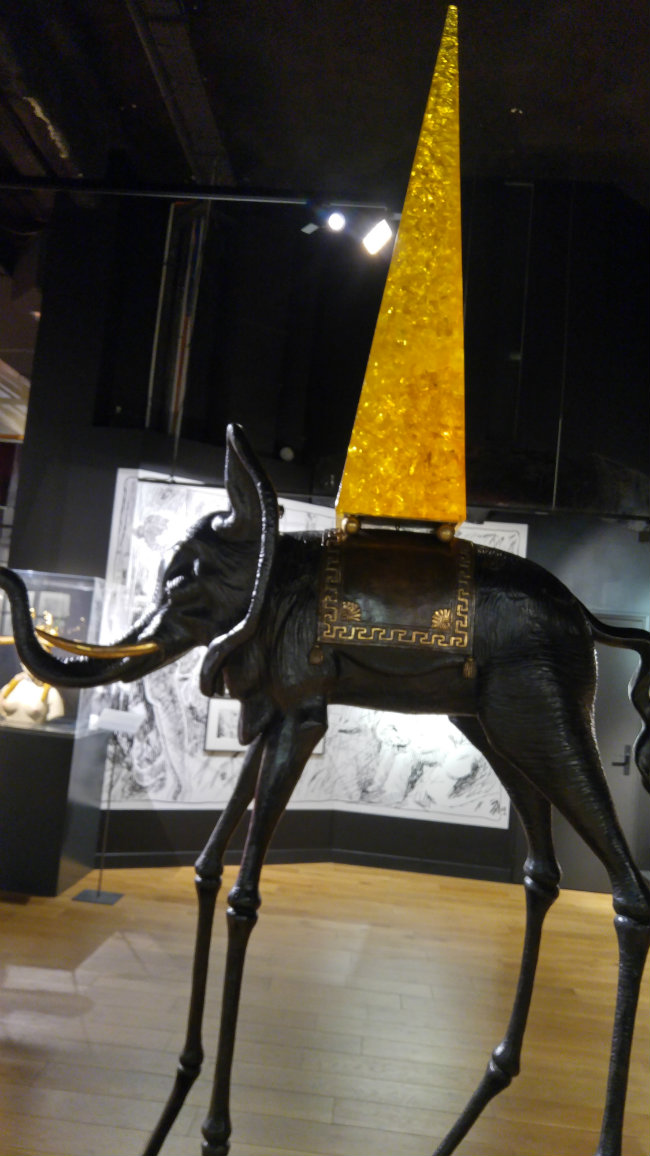
Space Elephant, Salvador Dali. Photo: Michele Kurlander
Note that the exhibit is entitled “Une Seconde Avant L’Eveil” and the “eveil” (awakening of Dalí) presumably takes place a moment later, within the pages of the book.
Large reproductions of drawings from that bande dessinée are placed on the walls of the gallery in a way so as to complement the artworks and sculptures already there.
On one page, for example, colored only in greens, one indeed finds Dalí lying in a liquid filled container from which pipes enter and exit; and while Seabearstein notes that he looks younger than when he died, Farida responds “Je vous dis qu’il vit.” Standing in front of the wall on which that page is enlarged, is a melting clock sculpture .
This combination– the drawings, the existing sculptures and other surrealist Dalí works, Schiaparelli clothing dangling from the ceiling, and the playing of dreamlike music– creates an unusual and spectacular experience in the Espace Dalí.
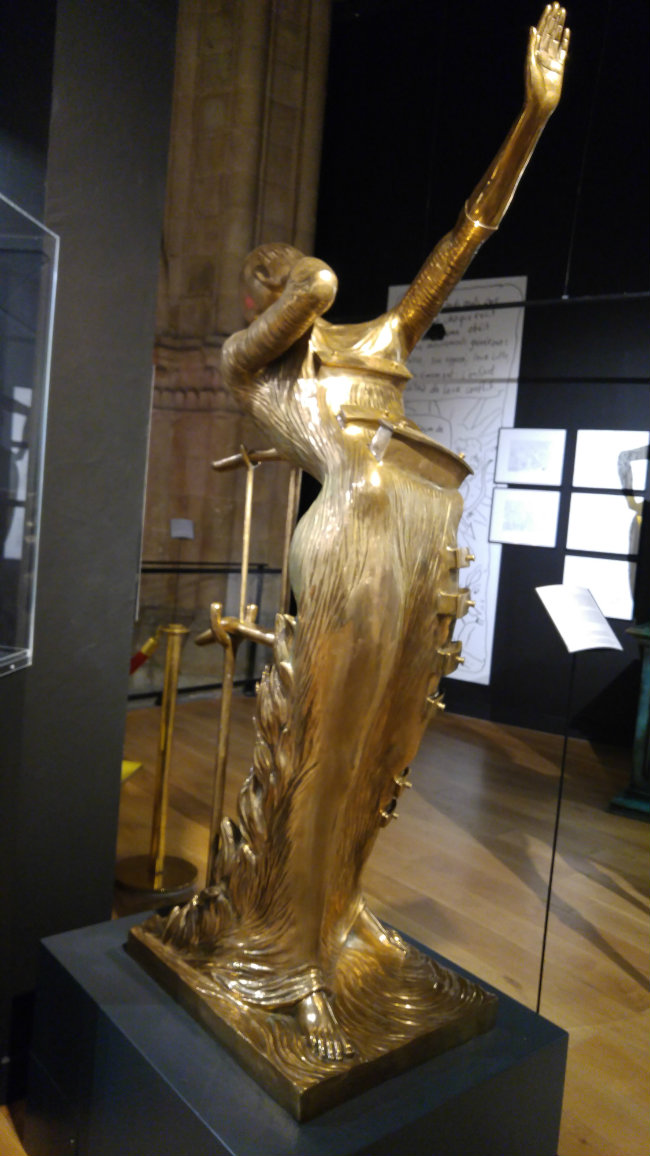
Woman in Flames, Salvador Dali. Photo: Michele Kurlander
But let’s not forget that this museum has always been a wondrous experience prior to the arrival of Monsieur Sfar. Salvador Dalí is to me the king of surrealism and the Espace Dalí has always been one of my favorite Paris escapes. My greatest love is for his truly strange but entrancing sculptural dreams- mostly created in soft wax and then cast in bronze.
A clock leans on a dark green branch and melts away – highlighting the impermanence of everything – a symbol that it is said be derived from Dalí’s dream of runny Camembert.
A woman on fire wears drawers opening and closing in her torso –symbolic of the secrets of love.
A spindly legged elephant bears on his back a bright orange obelisk. The legs (sometimes called the legs of desire) are dangerously long and almost nonexistent – a wonderment that they can support the body, depicting both weightlessness and strength.
Alice in Wonderland with head and hands of roses, holds a rope aloft.
The lips of Mae West are in the form of a bright red couch
The Buste de Femme Retrospectif, combines a painted porcelain milliner’s dummy head with various other salvaged objects. On her head is a bronze inkwell that incorporates a replica of Jean Francois Millet’s 1857 Angelus painting of peasants – which had always haunted Dalí as symbolic of sexual repression. She has a scarf of corn cobs around her neck and a hat that is a sculpture of a loaf of bread (which was a way of taking an object generally useful and making it “useless and aesthetic” according to Dalí – and as I understand, really an edible bread during its first presentation in 1933, until stolen and eaten by Picasso’s dog) along with ants crawling on her (Dalí’s symbol of death and decay and also sexual desire).
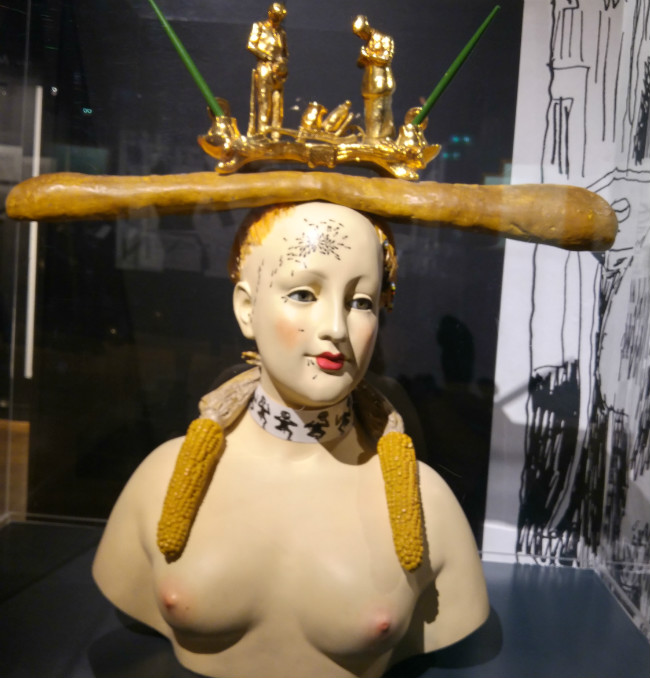
Buste de Femme Retrospectif, Salvador Dali. Photo: Michele Kurlander
Now, the existing collection is enhanced by the Sfar cartoons and the Schiaparelli fashions. Dalí worked on a number of fashion collections with Italian fashion designer Elsa Schiaparelli and on one side of the room near the hanging garments is a video featuring that design house.
Finally, just before leaving the exhibit one finds two wooden benches facing a screen on which there is a repeating loop of videos of Salvador Dalí talking to interviewers, interacting with his wife Gala, and engaged in other Dalinean activities.
There is much to see and hear and experience in this exhibit. You can run through the entire thing in an hour, or spend the afternoon reading each cartoon drawing and the background of each work of art– or follow my lead and visit more than once. The addition of this new exhibit to the existing space renders the already fascinating and exciting Espace Dalí a multileveled and even more fascinating place to visit.
Espace Dalí, 11 rue Poulbot, 18th. Open seven days a week from 10 am to 7 pm (9 pm the last Wednesday of each month). Take the metro to Montmarte Abbesses, Anvers, or Lamarck-Caulaincourt, and walk two minutes from Place du Tertre. Tickets can also be purchased online at daliparis.com. Adults: 11,5€, and reduced prices for students/seniors are also available.
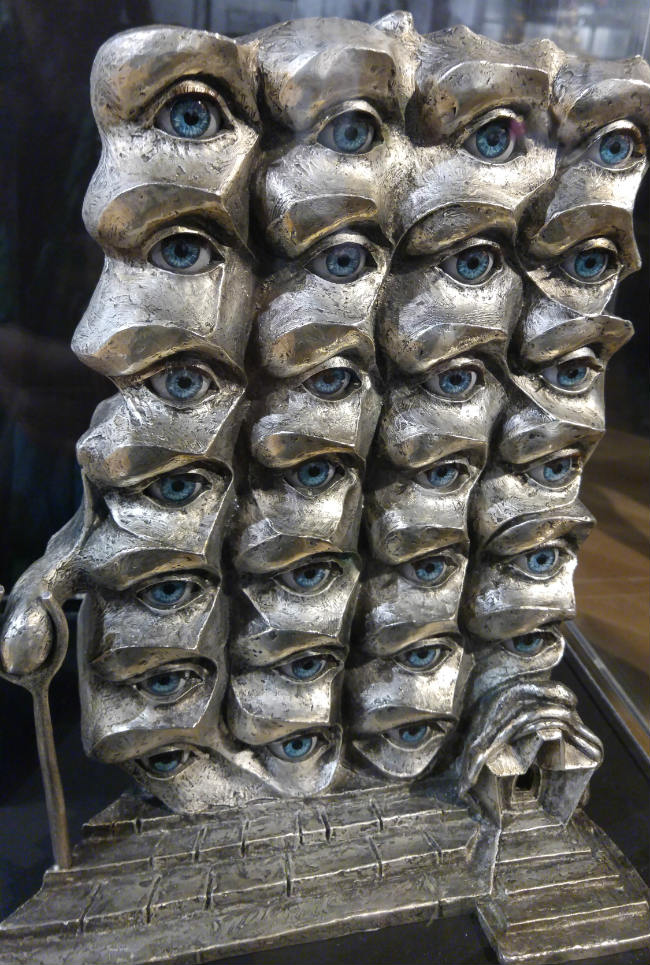
The Surrealist Eyes, Salvador Dali. Photo: Michele Kurlander
Lead photo credit : Profil du Temps, Salvador Dali, at the Espace Dali. Photo: Michele Kurlander

